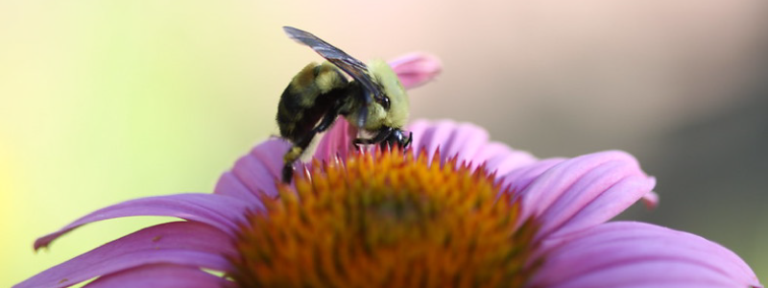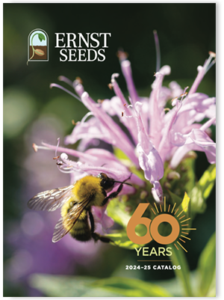by Rachel Sohmer
Given the current realities of pesticide use, habitat destruction, parasites and disease, climate change and air pollution among yet other stressors, there is no denying that conserving bees is a complex problem demanding complex solutions.
Poor nutrition, linked to widespread declines in both the abundance and diversity of flowering plants, has profound health consequences for bees and thus far-reaching ecological and economic consequences for human beings. The emerging field of bee nutritional ecology offers promising new perspectives on the issue, with growing evidence that developing nutritionally-targeted planting schemes is essential to creating high-quality pollinator habitat.
Ernst Seeds pollinator-friendly native seed mixes are carefully formulated to reflect the latest science on pollen nutrients and bee foraging behavior. With plant palettes specifically designed to support bee health, projects of any scale can help protect our wild and managed bee populations.

New Research Explores the Connection Between Pollen Nutrients and the Foraging Behavior of Bees
Many adult pollinators, including nearly all butterflies, require only nectar as their main source of food, picking up pollen unintentionally as they move from flower to flower. Bee larvae, however, depend not just on the carbohydrates in nectar but also the proteins, lipids and other nutrients found in pollen. By and large, nectar is nectar, but pollen is a different story. The nutritional composition of pollen varies widely among plant species and recent studies suggest that foraging bees pick and choose among different host plants to collect the right mix of nutrients for their developing brood. Just as the nutritional quality of pollen varies among plant taxa, the nutritional needs (or ‘intake targets’) of bees appears to vary from species to species. While bee health is strongly linked to protein intake, studies have shown it is the ratio of proteins to lipids in pollen that drives bee foraging behavior.
The ideal protein-to-lipid (P:L) ratio for a given bee species could be quite different from the average P:L ratio in the local landscape. The common eastern bumblebee (Bombus impatiens), for instance, displays an intake target of 4:1 P:L in the field – even higher in laboratory settings – yet high P:L-yielding plants tend to be relatively rare. Honey bees (Apis mellifera), on the other hand, appear to prefer P:L ratios between 1:1 and 2:1, although further studies are needed to determine whether honey bees selectively forage in this range or if instead their diet simply reflects the average P:L values available in the landscape. While the science of bee nutritional ecology is still in its larval stage, mounting evidence suggests that protein-to-lipid ratios play a key role in plant-pollinator interactions and should be closely considered when creating and restoring pollinator habitat.

Ernst Designs Seed Mixes Tailored to the Specific Nutritional Requirements of Bees
Ernst pollinator-friendly seed mixes incorporate the most current science on bee health and plant-pollinator relationships. Given a diversity of flowering species across a range of plant families, foraging bees may essentially ‘mix and match’ pollen resources for optimum nutrition throughout the growing season. For example, a bumblebee visiting a meadow established from Ernst Seed Showy Northeast Native Wildflower Mix will find hairy beardtongue (Penstemon hirsutus) and lanceleaf coreopsis (Coreopsis lanceolata) blooming together in late spring – an exceptionally high P:L ratio pollen source and an early-blooming member of the low P:L ratio aster family, respectively. Blue false indigo (Baptisia australis) and Ohio spiderwort (Tradescantia ohiensis) also bloom at this time, both producing pollen with P:L values closer to the bumblebee’s average target intake of 4:1. This nutritional diversity − available by design from spring through fall − is key to supporting bumblebees and other pollen-dependent pollinators as they work to maximize nutrition for themselves and their larvae.
Interestingly, research has shown there are intrinsic ecological benefits to be had when selecting plant palettes through the eyes of bees…or rather, their stomachs. Species diversity alone may not guarantee nutritional diversity, but designing for nutritional diversity will naturally result in a greater diversity of plant families and forms, which in turn attracts and supports a greater diversity of bees and other pollinators. These benefits are captured in Ernst Seeds pollinator-friendly perennial meadow seed mixes, which include a minimum of five flowering plant families, continuous bloom from early spring through the fall, and at least three species flowering concurrently in the late spring/early summer, summer and fall foraging windows. Pollinator support is further enhanced by the addition of native milkweeds, a nectar source for wild bees and an essential host plant for the imperiled monarch butterfly.
There is opportunity in virtually any project, large or small, to create high quality foraging habitat for bees and other pollinators. Ernst Seeds Pollinator Favorites are the foundation for landscapes that are not only beautiful, sustainable and ecologically resilient, but specifically designed for optimal bee health based on the latest scientific research.
Source
Vaudo, A. D., Tooker, J. F., Patch, H. M., Biddinger, D. J., Coccia, M., Crone, M. K., Fiely, M., et al. (2020). Pollen Protein: Lipid Macronutrient Ratios May Guide Broad Patterns of Bee Species Floral Preferences. Insects, 11(2), 132. MDPI AG.


